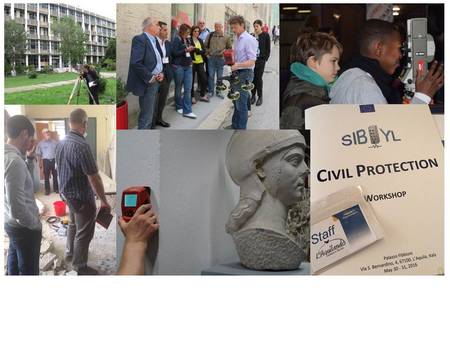Welcome to the SIBYL Project Page
Aims of SIBYL
The SeIsmic monitoring and vulneraBility framework for civiL protection or SIBYL project ran from January 2015 until December 2016. SIBYL’s aim was to develop an operational framework for Civil Protection (CP) authorities to rapidly and cost-effectively assess the seismic vulnerability of the built environment. This framework sets out to provide information to advise decision makers as to the most appropriate preventative actions. It covers cases where there is a need for short-notice vulnerability assessment in a pre-event situation, for example in the event of foreshocks, and the monitoring of the built environment’s dynamic vulnerability during a seismic sequence.
The framework is flexible enough to be employed over multiple spatial scales, and its modular structure eases its applicability to other natural hazard types. Furthermore. The training of CP personal in the developed methods will see the framework integrated into their operational protocols.
SIBYL was supported by the European Commission DG ECHO (European Civil Protection and Humanitarian Aid Operations) office within the 2014 call for prevention and preparedness projects in civil protection and marine pollution. A video outlining the project can be found here.
Why is this project necessary?
The occurrence of seismic swarms or foreshocks requires CP authorities to rapidly assess the threatened area’s vulnerability. This is especially true for those regions where there is a lack of up-to-date and reliable information. As the crisis unfolds (i.e., the occurrence of a main shock), there is moreover a need for real-time information that allows CP responders to adopt their actions to the evolving situation. Such a situation, which may also involve cross-border areas, is an example of what the Community Mechanism for Civil Protection must deal with.
The sorts of actions CP authorities will be called to undertake would include the dynamic tagging of those structures that have, or may become, unsafe, and the advising of the general population as to when they can move back to their homes, or in helping to plan emergency accommodation.
Unfortunately, most state-of-the-art approaches that provide such information are costly and expertise intensive, hence limiting their large scale applicability and thus their capacity to contribute to efficient prevention actions. Hence, the framework developed with SIBYL will provide a rapid, cost-effective and flexible means by which such information may be acquired. A video presentation of some aspects of this may be seen here. During the project, field exercises at test sites (Thessaloniki, Greece, Cologne, Germany, l’Aquila, Italy) were carried out. A video presentation describing may be seen here.
The heritage of SIBYL
The activities of the project call upon the experience gained from other EC supported actions. For example, the SAFER and REAKT projects contributed to the development of new low-cost seismic instrumentation, suitable for rapid deployment, as would be required in an evolving crisis. Likewise, within these and the MATRIX project, developments in our understanding and capacity to model temporal changes in vulnerability due to repeated seismic events have been made, all of which build upon the work on structural vulnerability undertaken in SYNER-G. Furthermore, the results and outcomes of the SENSUM project will allow the exploitation of remote sensing and in situ imaging.


